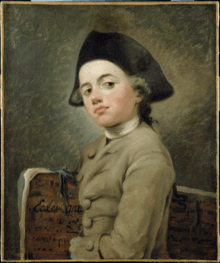Nicolas Bernard Lépicié

Nicolas Bernard Lépicié was a French painter (16 June 1735 – 15 September 1784), the son of two reputed engravers at the time, François-Bernard and Renee-Elisabeth, was introduced to the artistic and cultural environment by his parents.
Life
Nicolas-Bernard studied with reputed artists of the century including Carle Vanloo. In 1769 he was accepted to the Royal Academy of Painting and Sculpture in Paris. Three years later, in 1772, he became an assistant professor and, in 1777, a professor. Important names such as Carle Vernet, Jean-Frederic Schall, Jean-Antoine-Théodore Giroust, Jean-Joseph Taillasson, Henri-Pierre Danloux, Jean-Baptiste Regnault and Nicolas-Antoine Taunay perfected their talent under his guidance.
Work
Lépicié's work was visibly influenced by his father's friend, talented Chardin, whose themes were a source of inspiration for the artist's latter paintings. Nicolas Bernard Lépicié's collection of paintings is equally vast and various, ranging from portraits (Le Petit Dessinateur -1772 ; The Astronomer (i.e. Pierre Charles Le Monnier) - 1777) to historical scenes (Achilled and the Centaur Chiron - 1769) and domestic life reflections (A Mother Feeding her Child - 1774, Cour de ferme - 1784). For his paintings, Nicolas Bernard Lépicié revealed a preference for model Carle Vernet, who died the same year as the artist, 1784.
Lépicié reached his notoriety peak in the 18th century, when his work stood in comparison by that of Chardin and Greuze.
References
- Site officiel du musée du Louvre
- Nicolas Bernard Lépicié
- Philippe-Gaston Dreyfus, "Une dernière volonté de Nicolas-Bernard Lépicié" Bulletin de la Société de l'histoire de l'art français, 1er fascicule, Nogent-le-Rotrou, Daupeley-Gouverneur, 1910
| Wikimedia Commons has media related to Nicolas-Bernard Lépicié. |